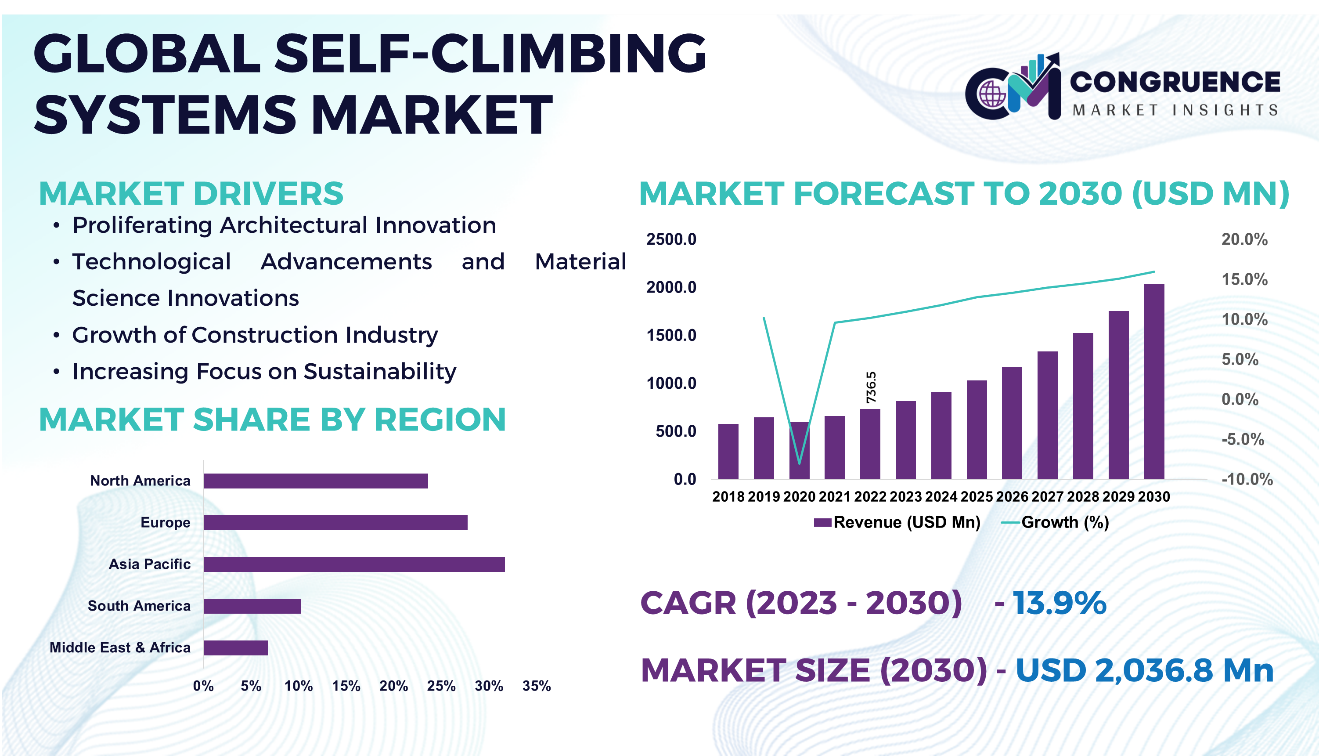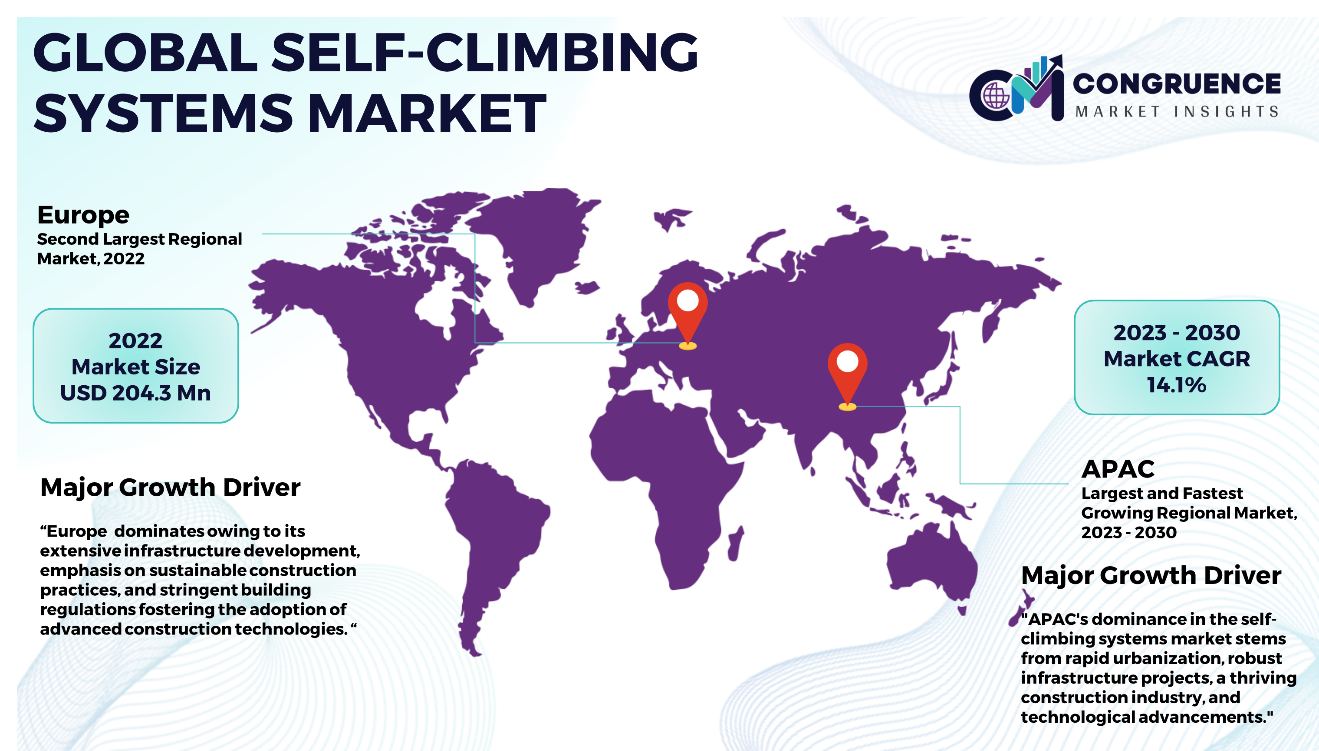Reports
The Global Self-Climbing Systems Market was valued at USD 736.5 Million in 2022 and is anticipated to reach a value of USD 2,036.8 Million by 2030 expanding at a CAGR of 13.9% between 2023 and 2030.
The paradigm-shifting mix of cutting-edge material science and creative technology is best represented by Self-Climbing Systems. These systems, which are mostly made of advanced composites and high-strength alloys, provide unmatched durability and adaptability, which are critical for projects involving vertical construction. With the use of hydraulic mechanisms and precision tracks, guided systems provide a smooth climb, improving operating safety and efficiency and enabling the building of tall structures more quickly. Moreover, unguided systems are flexible, using advanced sensors and automatic features to maneuver around complex building layouts on their own. Furthermore, the use of 3D printing technology in self-climbing systems signals the beginning of a revolutionary new era in construction methods. Construction processes are expedited by combining self-climbing systems with 3D printing capabilities. This allows for the precise and waste-free on-site manufacturing of complex architectural components. This convergence of technologies not only shortens construction schedules but also encourages sustainability, ushering in a new era in which skyscrapers are built quickly and with more environmental consciousness.

Self-Climbing Systems Market Major Driving Forces
Proliferating Architectural Innovation: The systems enable the efficient construction of complex geometries, irregular shapes, and iconic landmarks, allowing architects to push the capabilities of creativity and innovation in building design. From twisting skyscrapers to curvilinear bridges, self-climbing systems facilitate the realization of visionary architectural concepts, shaping the urban development around the world.
Technological Advancements and Material Science Innovations: Rapid advancements in materials science, robotics, and automation technologies are driving continuous innovation in self-climbing systems. From lightweight and durable construction materials to sophisticated sensors and control systems, these technological advancements enhance the capabilities and efficiency of self-climbing systems, aiding to construction companies seeking to improve project outcomes and gain a competitive edge in the market. Furthermore, ongoing research and development efforts focused on enhancing performance, reliability, and scalability, self-climbing systems are poised to play a central role in the future of construction.
Growth of Construction Industry: The overall growth of the construction industry, fueled by population growth, urbanization, and economic development, provides a fertile ground for the proliferation of self-climbing systems. As construction activity expands across residential, commercial, industrial, and infrastructure sectors, the demand for efficient construction technologies such as self-climbing systems is expected to rise correspondingly.
Increasing Focus on Sustainability: Self-climbing systems promote sustainability by optimizing material usage, reducing construction waste, and minimizing environmental impact compared to conventional construction methods.
Self-Climbing Systems Market Key Opportunities
Sustainability Initiatives: Increasing emphasis on sustainability and environmental responsibility within the construction industry creates opportunities for self-climbing systems that offer eco-friendly features and reduce carbon footprint. Integration of renewable energy sources, recycling of construction materials, and implementation of green building practices can align self-climbing systems with sustainability initiatives and attract environmentally conscious clients.
Ongoing Infrastructure Investment: Government initiatives and infrastructure investment programs around the world provide opportunities for self-climbing systems to play a vital role in the construction of bridges, tunnels, highways, and other critical infrastructure projects. Collaboration with government agencies and infrastructure developers can lead to long-term partnerships and lucrative contracts for self-climbing system providers.
Escalation of Modular Construction: The shift towards modular construction methods, including prefabrication and off-site assembly, presents opportunities for self-climbing systems to support the construction of modular buildings, housing units, and modular components. Integration with modular construction processes can streamline project timelines, reduce labor costs, and improve construction efficiency.
Self-Climbing Systems Market Key Trends
· There's a growing trend towards automated climbing forms, robotic arms, and remote-controlled systems are increasingly being integrated into self-climbing systems, reducing manual labor and improving construction precision.
· The integration of advanced materials, such as carbon fiber composites and high-strength alloys, is a key trend in self-climbing systems.
· Manufacturers and developers are prioritizing eco-friendly options in self-climbing system design and operation to align with green building standards and environmental regulations.
· The systems are being designed to facilitate the assembly of modular components, enabling faster construction timelines, reduced on-site labor, and increased project efficiency.
· Digitalization and BIM are transforming the self-climbing systems market by improving project planning, coordination, and execution. Digital twin simulations, real-time monitoring, and predictive analytics are being integrated into self-climbing systems to optimize construction processes and enhance project outcomes.
· The development of safety-enhanced self-climbing systems. Features such as advanced fall protection systems, proximity sensors, and automated safety checks are being incorporated into self-climbing systems to minimize risks and ensure compliance with safety regulations.
· The trend towards urbanization and the construction of high-rise buildings is fueling demand for self-climbing systems, enabling the efficient construction, supporting the development of modern cities and urban infrastructure.
Region-wise Market Insights
Asia Pacific accounted for the largest market share at 31.67% in 2022 whereas and is expected to register the fastest growth, expanding at a CAGR of 14.1% between 2023 and 2030.

Due to the region's large infrastructure investments and booming construction industry, self-climbing devices are in high demand throughout North America. The adoption of cutting-edge construction technology is being fueled by the region's strong demand for towering skyscrapers and commercial complexes. Furthermore, the market for self-climbing systems in Europe gains from large-scale infrastructure development programs and a focus on environmentally friendly building techniques. Furthermore, the need for self-climbing systems is increasing throughout the region due to the adoption of cutting-edge construction techniques and strict building regulations. Asia Pacific presents itself as a robust and profitable market for self-climbing systems, driven by population development, fast urbanization, and rising construction project spending. The market for self-climbing systems has enormous potential in Latin America, the Middle East, and Africa due to urbanization and infrastructure building initiatives. There is a lot of building going on in South America, and nations like South Africa and the United Arab Emirates are investing in large-scale infrastructure projects in the Middle East and Africa.
Market Competition Landscape
The self-climbing systems industry is characterized by fierce competition among major manufacturers vying for market share. Well-established businesses with wide product offers and a wealth of industry expertise control the market. Furthermore, newcomers are making headway with creative fixes and assertive marketing approaches. The competitive landscape is being shaped by technological developments, product differentiation, and strategic collaborations as businesses strive to stay ahead of the curve and take advantage of changing market trends.
Key players in the global Self-Climbing Systems market implement various organic and inorganic strategies to strengthen and improve their market positioning. Prominent players in the market include:
· PERI SE
· Doka GmbH (Umdasch Group)
· Layher Scaffolding Systems
· ULMA C y E, S.Coop.
· RMD Kwikform
· Brand Industrial Services, Inc.
· ALPI
· MEVA
· PASCHAL International
· Hünnebeck
· Beijing Zulin Formwork & Scaffolding Co. Ltd.
· Nanjing Guhua Metalwork Co., Ltd.
· Hunan Standard Steel Co., Ltd and Husteel Industry Group
· Suzhou TECON Construction Technology Co., Ltd.
· Ringlock Scaffolding System
· 3S Industry (Ficont Industry (Beijing) Co., Ltd.)
|
Report Attribute/Metric |
Details |
|
Market Revenue in 2022 |
USD 736.5 Million |
|
Market Revenue in 2030 |
USD 2,036.8 Million |
|
CAGR (2023 – 2030) |
13.9% |
|
Base Year |
2022 |
|
Forecast Period |
2023 – 2030 |
|
Historical Data |
2018 to 2022 |
|
Forecast Unit |
Value (US$ Mn) |
|
Key Report Deliverable |
Revenue Forecast, Growth Trends, Market Dynamics, Segmental Overview, Regional and Country-wise Analysis, Competition Landscape |
|
Segments Covered |
· By Type (Hydraulic Self-Climbing Systems, Electric Self-Climbing Systems, and Pneumatic Self-Climbing Systems) · By Mechanism (Guided Climbing, and Unguided Climbing) · By End-Use (Bridges, High-rise Buildings. Industrial Structures, and Others) |
|
Geographies Covered |
North America: U.S., Canada and Mexico Europe: Germany, France, U.K., Italy, Spain, and Rest of Europe Asia Pacific: China, India, Japan, South Korea, Southeast Asia, and Rest of Asia Pacific South America: Brazil, Argentina, and Rest of Latin America Middle East & Africa: GCC Countries, South Africa, and Rest of Middle East & Africa |
|
Key Players Analyzed |
PERI SE, Doka GmbH (Umdasch Group), Layher Scaffolding Systems, ULMA C y E, S.Coop., RMD Kwikform, Brand Industrial Services, Inc., ALPI, MEVA, PASCHAL International, Hünnebeck, Beijing Zulin Formwork & Scaffolding Co. Ltd., Nanjing Guhua Metalwork Co., Ltd., Hunan Standard Steel Co.,Ltd and Husteel Industry Group, Suzhou TECON Construction Technology Co., Ltd., Ringlock Scaffolding System, and 3S Industry (Ficont Industry (Beijing) Co., Ltd.) |
|
Customization & Pricing |
Available on Request (10% Customization is Free) |
